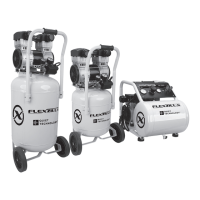5
Flexzilla Electric Operated, Oil-Free Portable Air Compressors
3. OPERATION
3.1 Test Run
Before using the air compressor for the rst me
complete a test run as follows:
1.) Turn the power switch to the OFF posion.
Plug the power supply cord into a power supply
socket.
Start the air compressor by turning the power
switch to the ON posion.
The pressure gauge reading will slowly rise as
pressure increases inside the air tank.
When the gauge reading reaches 120 PSI – 125 PSI,
the pressure switch will automacally turn the
power o.
This indicates the compressor is working normally.
2.) Turn the power switch to the OFF posion, unplug
the power supply cord and release the air in the
tank by pulling on the safety valve. At this point
proceed to the next step.
Note: If the air compressor is not working properly,
the pressure gauge will indicate that there is a
decrease in pressure in the air tank. If there is an
air leak from the compressor the pressure in the
air tank decreases, the pressure switch resets and
the motor automacally turns back on.
If you detect an air leakage, turn the power switch
to the OFF posion, release the air from the tank
by pulling on the safety valve. Unplug the power
supply cord and contact Customer Support for
assistance.
3.2 Daily Operaon
Starng the compressor:
1.) Turn the power switch to the OFF posion.
2.) Aach air hose to the 1/4” Universal/Industrial
Quick Connector.
3.) Check that all air ngs are ght and close manual
drain valve.
4.) Maintain 2 feet of open space around the air
compressor.
5.) Plug the power supply cord into a 110V 20 amp
outlet/breaker.
6.) Turn the power switch to the ON posion.
7.) Let the motor run and tank ll unl motor
turns o.
8.) To regulate air ow. While the air compressor is
running, turn on your tool and turn the regulator
knob to the right increasing the pressure.
Turn the pressure up unl the desired pressure is
reached.
9.) Operate air tool normally. Do not use connuously
(running) for more than (8-12) hours.
2. SET UP INSTRUCTIONS
2.1 Inial Set Up
1.) Read safety warnings before seng up air
compressor.
2.2 Locaon
1.) In order to avoid damaging the air compressor,
do not incline the air compressor transversely or
longitudinally more than 10°.
2.) Place air compressor at least 2 feet away from
obstacles that may prevent proper venlaon.
Do not place air compressor in an area:
a. Where there is evidence of oil or gas leaks.
b. Where ammable gas vapors or materials may
be present.
c. Where air temperatures fall below 32°F or
exceed 104°F.
d. Where extremely dirty air or water could be
drawn into the air compressor.
2.3 Electrical
1.) USE OF AN EXTENSION CORD IS NOT RECOMMENDED
because it could cause the compressor motor to
overheat. It’s preferable to use addional air hose
instead of an extension cord.
2.) If use of an extension cord is unavoidable, be
sure to use one heavy enough to carry the current
your compressor will draw. Minimum cord sizes are
as follows:
Ampere
Rang
Range
Voltage Length of cord in .
120V 25 . 50 100 . 150 . 200 . 250 .
240V 50 . 100 . 200 . 300 . 400 . 500 .
8 - 10 18 14 12 10 8 8
10 - 12 16 14 10 8 8 6
12 - 14 16 12 10 8 6 6
14 - 16 16 12 10 8 6 6
16 - 18 14 12 8 8 6 4
18 - 20 14 12 8 6 6 4
3.) Use only a 3-wire extension cord that has a 3-blade
grounding plug and a 3-slot receptacle that will
accept the plug of the compressor.
4.) Examine cords before using. Do not use the
compressor if its cord is damaged. Do not use a
damaged extension cord.
5.) Keep cords away from heat and sharp edges. Do
not pull on a cord to disconnect a plug – grasp
the plug.
6.) Always shut o the compressor pressure switch
before unplugging the compressor.

